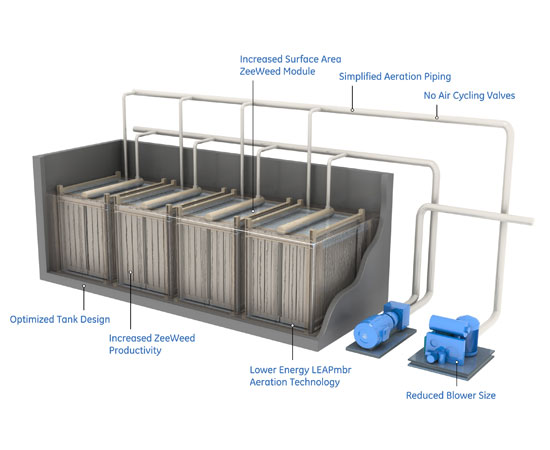Why Membrane Bioreactor is the Future of Wastewater Treatment in Industries
Why Membrane Bioreactor is the Future of Wastewater Treatment in Industries
Blog Article
Membrane Bioreactors Described: Reliable Solutions for Clean Water
Membrane layer bioreactors (MBRs) have actually become an innovative solution for addressing the pushing difficulties of wastewater therapy. By incorporating organic processes with advanced membrane layer filtering, MBRs not only improve the high quality of cured water yet also lower the spatial demands of treatment centers. As environmental concerns heighten, the role of MBR modern technology in promoting lasting water administration comes to be increasingly considerable. The complexities of their procedure, benefits, and possible applications warrant a closer exam to completely recognize their impact on the future of water treatment.

What Are Membrane Bioreactors?
Membrane bioreactors (MBRs) are advanced wastewater therapy systems that incorporate biological deterioration procedures with membrane filtering innovation. This combination enables the reliable removal of impurities from water, making MBRs a recommended option in numerous applications, including local wastewater treatment and commercial effluent monitoring.

One of the vital benefits of MBRs is their capability to create premium effluent, usually suitable for reuse in watering or commercial procedures. Additionally, MBRs require a smaller footprint contrasted to standard therapy systems, making them optimal for urban setups where space may be restricted.
Furthermore, MBRs can effectively take care of varying influent lots and are less prone to the results of toxic shocks. These characteristics add to their expanding appeal as a lasting service for attending to the raising demand for tidy water while decreasing ecological influences.
Just How Membrane Layer Bioreactors Job
While the operation of membrane bioreactors (MBRs) may appear complex, it fundamentally focuses on the harmony in between biological procedures and membrane filtering. MBRs incorporate a biological therapy process, usually triggered sludge, with a membrane splitting up device to treat wastewater efficiently.
In an MBR system, wastewater is first introduced into a bioreactor where microbes weaken raw material and other contaminants. The organic task lowers the concentration of toxins while promoting the development of biomass. Following this biological therapy, the blended liquor goes through membrane layer purification, which can be microfiltration or ultrafiltration, relying on the wanted effluent top quality.
The membrane layers serve as a physical barrier, permitting water and tiny solutes to pass while keeping put on hold solids and larger molecules. This makes it possible for the system to maintain a high concentration of biomass within the reactor, boosting the treatment performance.
Moreover, the continual splitting up of cured water from the biomass helps with a portable layout and decreases the impact of the treatment center. In general, the mix of organic destruction and membrane filtration in MBRs leads to dependable and reliable wastewater therapy, making certain top notch effluent suitable for numerous applications.
Advantages of MBR Modern Technology
Among the vital benefits of membrane bioreactor (MBR) modern technology is its ability to generate top notch effluent with a considerably reduced impact contrasted to traditional wastewater therapy approaches. MBR systems efficiently integrate organic treatment and membrane filtering, leading to superior removal of impurities, consisting of put on hold solids, pathogens, and raw material. This capacity brings about effluent that often satisfies or surpasses rigid governing criteria for reuse and discharge.
Additionally, MBR technology permits greater biomass focus, which enhances the therapy effectiveness and lowers the called for reactor quantity. This small layout is especially valuable in metropolitan areas where space is limited. The operational flexibility of MBR systems also means they can adapt to differing influent high qualities and circulation prices, making them appropriate for a large variety of applications.
Additionally, the decreased sludge manufacturing associated with MBR procedures adds to reduce operational and maintenance expenses. The membrane layers work as a physical obstacle, reducing the threat of obstructing and allowing longer functional periods between cleansing. Overall, the benefits of MBR technology make it an appealing solution for sustainable wastewater therapy, resolving both see this page ecological problems and the requirement for reliable source management.
Applications of Membrane Layer Bioreactors
With their convenience and efficiency, membrane bioreactors (MBRs) find applications throughout various sectors, consisting of metropolitan wastewater treatment, industrial procedures, and even water reclamation. In metropolitan setups, MBRs provide a portable service for treating wastewater, efficiently eliminating pollutants while simultaneously producing top quality effluent that fulfills rigid regulatory criteria. This makes them especially ideal for areas with restricted space.
In industrial applications, MBR innovation is used for dealing with procedure water, especially in markets such as food and beverage, pharmaceuticals, and petrochemicals. These industries take advantage of MBRs' capability to take care of high natural tons and their efficiency in recuperating useful sources from wastewater, such as nutrients and water.
Additionally, MBRs play an essential function in water recovery initiatives, enabling the reuse of treated wastewater for watering, industrial procedures, and even as drinkable water after further therapy (Membrane Bioreactor). Their effectiveness in removing pathogens and toxins makes them a dependable selection for ensuring water high quality in different reuse applications
Future of Water Therapy Solutions
The future of water therapy remedies is positioned for transformative improvements driven by technical technology and enhancing ecological awareness. As international water scarcity ends up being a pressing problem, new methodologies, including membrane bioreactor (MBR) systems, are readied to play a critical role in improving the efficiency and sustainability of water click this therapy procedures.
Emerging technologies such as expert system and artificial intelligence are anticipated to enhance therapy operations, allowing for real-time monitoring and anticipating maintenance. This will improve the total dependability and efficiency of water treatment centers. Additionally, innovations in membrane materials, find this such as graphene and nanofiltration, assure to increase permeation rates and lower fouling, resulting in reduced energy consumption and functional costs.
In addition, the assimilation of renewable power sources right into water therapy plants will certainly contribute to greener practices. The circular economic climate design will likewise acquire grip, encouraging the healing of beneficial resources from wastewater, such as nutrients and power.
Conclusion

Membrane layer bioreactors (MBRs) have emerged as an innovative option for attending to the pressing challenges of wastewater treatment. By incorporating organic procedures with sophisticated membrane layer purification, MBRs not just improve the top quality of cured water yet likewise minimize the spatial requirements of treatment facilities.One of the crucial advantages of membrane layer bioreactor (MBR) modern technology is its capacity to produce top quality effluent with a dramatically minimized footprint compared to standard wastewater treatment techniques.With their adaptability and efficiency, membrane bioreactors (MBRs) discover applications across numerous fields, including municipal wastewater therapy, industrial procedures, and even water recovery.In conclusion, membrane bioreactors represent a substantial innovation in wastewater therapy technology, integrating biological procedures with reliable membrane layer purification to create top quality effluent.
Report this page